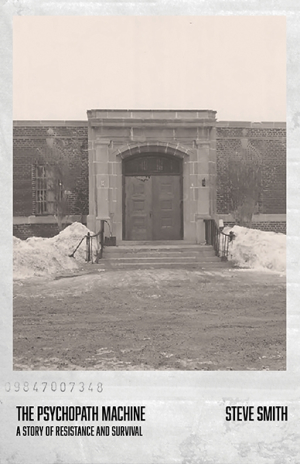
The Psychopath Machine
A Story of Resistance and Survival
This is an important testimonial about the cruel treatment of patients by doctors who conduct irresponsible research.
In The Psychopath Machine, Steve Smith offers shocking testimony about his daunting time in Ontario’s Oak Ridge asylum, making it clear that human subjects, especially those in prison, are vulnerable and entitled to protection.
The Psychopath Machine begins in Oak Ridge in 1968. Opening paragraphs set the tone for the book, in which Smith’s conversational, calming style does not always match the alarming content of the text. Smith starts off by describing his uncanny friendship with Peter, a fellow asylum patient who is guilty of raping and murdering children. Peter is a psychopath and Smith is mistaken for one too.
Such stunning revelations come alongside the casual mention of the fact that doctors and guards enlisted both patients in experiments involving nudity and drugs. One of these doctors even wrote research publications about his attempts to rid his patients of psychosis. Smith also flashes back to a childhood that involved divorced and estranged parents and a sexually abused brother.
This self-portrait seems frank throughout. Smith reveals things that others might have been tempted to hide, including accounts of recreational drug use, homophobia, and stealing. He relates multiple arrests, hospitalization, and forced participation in asylum experiments with refreshing candidness.
Smith is able to describe events from multiple perspectives. He honestly captures the humiliation he felt as a participant in the experiments, as well as the guilt brought on when he was elevated to “patient-teacher,” charged with observing small groups of patients and noting their responses to drugs and to each other. Sometimes his stories appear implausible, and this, too, becomes a theme: what and who is seen as credible?
For instance, Smith captures the absurdity of doctors relying on patients to serve as co-researchers/“patient-teachers” who assist with experiments by calling into question (perhaps unintentionally) his own recollection of the event. Smith’s use of drugs and status as an inmate did not always position him as the type of person one might believe, but his use of second-person point of view, though often awkward, does serve as a technique to persuade the reader. Still, Smith writes movingly of his efforts to uncover the wrongs that were committed at Oak Ridge.
This memoir centers on themes of the complexities of searching for truth and justice. Short chapters capture Smith’s longing, particularly for validation of his experiences, as well as his attempts to achieve justice for himself and others who were hurt. In the end, Smith is a convincing narrator, and his resilience is encouraging.
The Psychopath Machine is an important testimonial about the cruel treatment of patients by doctors who conduct irresponsible research; it is a story that needed to be told.
Reviewed by
Kaavonia Hinton
Disclosure: This article is not an endorsement, but a review. The publisher of this book provided free copies of the book and paid a small fee to have their book reviewed by a professional reviewer. Foreword Reviews and Clarion Reviews make no guarantee that the publisher will receive a positive review. Foreword Magazine, Inc. is disclosing this in accordance with the Federal Trade Commission’s 16 CFR, Part 255.
